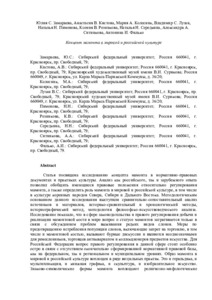History of World and Russian Mammoth Studies
Скачать файл:
URI (для ссылок/цитирований):
http://elib.sfu-kras.ru/bitstream/handle/2311/135533/12_Luzan.pdf?sequence=1https://elib.sfu-kras.ru/handle/2311/142629
Автор:
Лузан, В. С.
Ситникова, А. А.
Кистова, А. В.
Филько, А. И.
Замараева, Ю. С.
Резникова, К. В.
Колесник, М. А.
Копцева, Н. П.
Пименова, Н. Н.
Коллективный автор:
Гуманитарный институт
Кафедра культурологии
Кафедра рекламы и социально-культурной деятельности
Дата:
2020-07Журнал:
Журнал Сибирского федерального университетаКвартиль журнала в Scopus:
Q3Библиографическое описание:
Лузан, В. С. History of World and Russian Mammoth Studies [Текст] / В. С. Лузан, А. А. Ситникова, А. В. Кистова, А. И. Филько, Ю. С. Замараева, К. В. Резникова, М. А. Колесник, Н. П. Копцева, Н. Н. Пименова, Н. Н. Пименова // Журнал Сибирского федерального университета: Гуманитарные науки. — 2020. — Т. 13 (№ 7). — С. 1163-1181Аннотация:
The article is devoted to the study of the concept of the mammoth in regulatory
documents and cultural practices. The analysis of both Russian and international
experience allowed to generalise the existing legal provisions regarding the regulation
of mammoths, as well as to determine the role of mammoths in the world and Russian
culture, including the culture of the indigenous peoples of the North, Siberia and the
Far East. The methodological basis of the study is represented by the comparative
analysis of sources and materials, historical-comparative and chronological methods, the
historiographic method, as well as methods of philosophical and art history analysis. The
study revealed the fact that in the field of legislation and legal regulation of extraction
and sale of mammoth ivory in the world, the issue of the status of mammoths is raised
only in connection with a discussion of the survival of rare species of elephants.
Measures to prevent extermination of elephant population, encompassing a ban on trade,
including trade of mammoth ivory, cause heated discussions and are controversial for
craftsmen, antique dealers and art collectors. The issue of legal regulation in this area
is particularly acute for the Russian Federation, due to the lack of a finalised legal and
regulatory framework, both at the federal, regional and municipal levels. The image of the
mammoth in the world and Russian culture is embodied in a number of visual practices.
These are heraldry, animation, book graphics, sculpture and fine art. Sign and symbolic
forms of the mammoth embody religious and mythological characteristics of the animal,
demonstrating its significance in people’s worldview, as well as indicating of the “living”
memory of it in the modern world.

